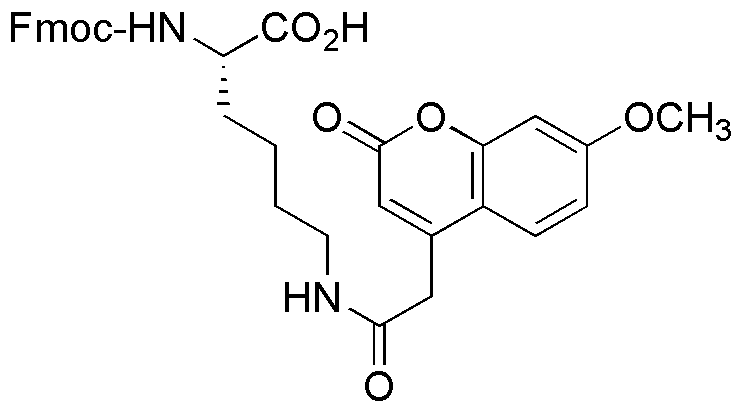Na-Fmoc-Ne-7-methoxycoumarin-4-acetyl-L-lysine is widely utilized in research focused on:
- Peptide Synthesis: This compound serves as a protective group in the synthesis of peptides, allowing for selective reactions and facilitating the formation of complex structures.
- Fluorescent Probes: Its unique structure enables it to act as a fluorescent probe, making it valuable in biological imaging and tracking cellular processes in real-time.
- Drug Development: The compound is used in the development of new pharmaceuticals, particularly in designing targeted therapies that require precise molecular interactions.
- Bioconjugation: It allows for the conjugation of biomolecules, enhancing the stability and functionality of therapeutic agents, which is crucial in the field of biomedicine.
- Research in Cancer Biology: The compound's properties make it a useful tool in cancer research, aiding in the study of tumor behavior and the development of novel treatment strategies.
General Information
Properties
Safety and Regulations
Applications
Na-Fmoc-Ne-7-methoxycoumarin-4-acetyl-L-lysine is widely utilized in research focused on:
- Peptide Synthesis: This compound serves as a protective group in the synthesis of peptides, allowing for selective reactions and facilitating the formation of complex structures.
- Fluorescent Probes: Its unique structure enables it to act as a fluorescent probe, making it valuable in biological imaging and tracking cellular processes in real-time.
- Drug Development: The compound is used in the development of new pharmaceuticals, particularly in designing targeted therapies that require precise molecular interactions.
- Bioconjugation: It allows for the conjugation of biomolecules, enhancing the stability and functionality of therapeutic agents, which is crucial in the field of biomedicine.
- Research in Cancer Biology: The compound's properties make it a useful tool in cancer research, aiding in the study of tumor behavior and the development of novel treatment strategies.
Documents
Safety Data Sheets (SDS)
The SDS provides comprehensive safety information on handling, storage, and disposal of the product.
Product Specification (PS)
The PS provides a comprehensive breakdown of the product’s properties, including chemical composition, physical state, purity, and storage requirements. It also details acceptable quality ranges and the product's intended applications.
Certificates of Analysis (COA)
Search for Certificates of Analysis (COA) by entering the products Lot Number. Lot and Batch Numbers can be found on a product’s label following the words ‘Lot’ or ‘Batch’.
Numéro de catalogue
Numéro de lot/série
Certificates Of Origin (COO)
This COO confirms the country where the product was manufactured, and also details the materials and components used in it and whether it is derived from natural, synthetic, or other specific sources. This certificate may be required for customs, trade, and regulatory compliance.
Numéro de catalogue
Numéro de lot/série
Safety Data Sheets (SDS)
The SDS provides comprehensive safety information on handling, storage, and disposal of the product.
DownloadProduct Specification (PS)
The PS provides a comprehensive breakdown of the product’s properties, including chemical composition, physical state, purity, and storage requirements. It also details acceptable quality ranges and the product's intended applications.
DownloadCertificates of Analysis (COA)
Search for Certificates of Analysis (COA) by entering the products Lot Number. Lot and Batch Numbers can be found on a product’s label following the words ‘Lot’ or ‘Batch’.
Numéro de catalogue
Numéro de lot/série
Certificates Of Origin (COO)
This COO confirms the country where the product was manufactured, and also details the materials and components used in it and whether it is derived from natural, synthetic, or other specific sources. This certificate may be required for customs, trade, and regulatory compliance.


